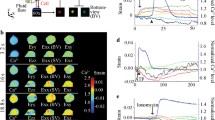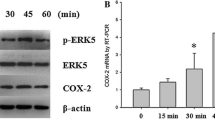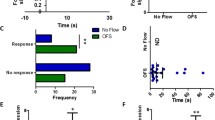Abstract
Growing evidence suggests that aging compromises the ability of the skeleton to respond to anabolic mechanical stimuli. Recently, we reported that treating senescent mice with Cyclosporin A (CsA) rescued aging-related deficits in loading-induced bone formation. Given that the actions of CsA are often attributed to inhibition of the calcineurin/NFAT axis, we hypothesized that CsA enhances gene expression in bone cells exposed to fluid flow, by inhibiting nuclear NFATc1 accumulation. When exposed to flow, MC3T3-E1 osteoblastic cells exhibited rapid nuclear accumulation of NFATc1 that was abolished by CsA treatment. Under differentiation conditions, intermittent CsA treatment enhanced gene expression of late osteoblastic differentiation markers and activator protein 1 (AP-1) family members. Superimposing flow upon CsA further enhanced expression of the AP-1 members Fra-1 and c-Jun. To delineate the contribution of NFAT in this response, cells were treated with VIVIT, a specific inhibitor of the calcineurin/NFAT interaction. Treatment with VIVIT blocked flow-induced nuclear NFATc1 accumulation but did not recapitulate the CsA-mediated enhancement of flow-induced AP-1 component gene expression. Taken together, our study is the first to demonstrate that CsA enhances mechanically-induced gene expression of AP-1 components in bone cells, and suggests that this response requires calcineurin-dependent mechanisms that are independent of inhibiting NFATc1 nuclear accumulation.





Similar content being viewed by others
Abbreviations
- AP-1:
-
Activator protein-1
- NFAT:
-
Nuclear factor of activated T cells
- CsA:
-
Cyclosporin A
- GSK-3β:
-
Glycogen synthase kinase-3β
- Elk-1:
-
ETS-like transcription factor 1
- NF-κB:
-
Nuclear factor κB
- CREB:
-
Cyclic AMP response element-binding protein
- ALP:
-
Alkaline phosphatase
- OPN:
-
Osteopontin
- OCN:
-
Osteocalcin
- Cox2:
-
Cyclooxygenase 2
References
Akhouayri, O., and R. St-Arnaud. Differential mechanisms of transcriptional regulation of the mouse osteocalcin gene by Jun family members. Calcif. Tissue Int. 80:123–131, 2007.
Alles, N., N. S. Soysa, J. Hayashi, M. Khan, A. Shimoda, H. Shimokawa, O. Ritzeler, K. Akiyoshi, K. Aoki, and K. Ohya. Suppression of NF-kappaB increases bone formation and ameliorates osteopenia in ovariectomized mice. Endocrinology 151:4626–4634, 2010.
Aramburu, J., A. Rao, and C. B. Klee. Calcineurin: from structure to function. Curr. Top. Cell Regul. 36:237–295, 2000.
Aramburu, J., M. B. Yaffe, C. Lopez-Rodriguez, L. C. Cantley, P. G. Hogan, and A. Rao. Affinity-driven peptide selection of an NFAT inhibitor more selective than cyclosporin A. Science 285:2129–2133, 1999.
Asanuma, M., N. Ogawa, S. Nishibayashi, Y. Kondo, and A. Mori. Effects of repeated injection of cyclosporin A on pentylenetetrazol-induced convulsion and cyclophilin mRNA levels in rat brain. Neurochem. Res. 20:101–105, 1995.
Behrens, A., J. Haigh, F. Mechta-Grigoriou, A. Nagy, M. Yaniv, and E. F. Wagner. Impaired intervertebral disc formation in the absence of Jun. Development 130:103–109, 2003.
Bito, H., K. Deisseroth, and R. W. Tsien. CREB phosphorylation and dephosphorylation: a Ca(2+)- and stimulus duration-dependent switch for hippocampal gene expression. Cell 87:1203–1214, 1996.
Celil Aydemir, A. B., S. Lee, D. Won Kim, T. R. Gardner, D. Prince, J. Mok Ahn, and F. Y. Lee. Nuclear factor of activated T cell mediates proinflammatory gene expression in response to mechanotransduction. Ann. N Y Acad. Sci. 1117:138–142, 2007.
Celil Aydemir, A. B., H. Minematsu, T. R. Gardner, K. O. Kim, J. M. Ahn, and F. Y. Lee. Nuclear factor of activated T cells mediates fluid shear stress- and tensile strain-induced Cox2 in human and murine bone cells. Bone 46:167–175, 2010.
Chang, J., Z. Wang, E. Tang, Z. Fan, L. McCauley, R. Franceschi, K. Guan, P. H. Krebsbach, and C. Y. Wang. Inhibition of osteoblastic bone formation by nuclear factor-kappaB. Nat. Med. 15:682–689, 2009.
Cheung, A. M., and L. Giangregorio. Mechanical stimuli and bone health: what is the evidence? Curr. Opin. Rheumatol. 24:561–566, 2012.
D’Alonzo, R. C., N. Selvamurugan, G. Karsenty, and N. C. Partridge. Physical interaction of the activator protein-1 factors c-Fos and c-Jun with Cbfa1 for collagenase-3 promoter activation. J. Biol. Chem. 277:816–822, 2002.
Donahue, T. L., T. R. Haut, C. E. Yellowley, H. J. Donahue, and C. R. Jacobs. Mechanosensitivity of bone cells to oscillating fluid flow induced shear stress may be modulated by chemotransport. J. Biomech. 36:1363–1371, 2003.
Donahue, S. W., C. R. Jacobs, and H. J. Donahue. Flow-induced calcium oscillations in rat osteoblasts are age, loading frequency, and shear stress dependent. Am. J. Physiol. Cell Physiol. 281:C1635–C1641, 2001.
Eferl, R., A. Hoebertz, A. F. Schilling, M. Rath, F. Karreth, L. Kenner, M. Amling, and E. F. Wagner. The Fos-related antigen Fra-1 is an activator of bone matrix formation. EMBO J. 23:2789–2799, 2004.
Flanagan, W. M., B. Corthesy, R. J. Bram, and G. R. Crabtree. Nuclear association of a T-cell transcription factor blocked by FK-506 and cyclosporin A. Nature 352:803–807, 1991.
Frischbutter, S., C. Gabriel, H. Bendfeldt, A. Radbruch, and R. Baumgrass. Dephosphorylation of Bcl-10 by calcineurin is essential for canonical NF-kappaB activation in Th cells. Eur. J. Immunol. 41:2349–2357, 2011.
Grigoriadis, A. E., K. Schellander, Z. Q. Wang, and E. F. Wagner. Osteoblasts are target cells for transformation in c-fos transgenic mice. J. Cell Biol. 122:685–701, 1993.
Hipskind, R. A., and G. Bilbe. MAP kinase signaling cascades and gene expression in osteoblasts. Front Biosci 3:d804–d816, 1998.
Inoue, D., S. Kido, and T. Matsumoto. Transcriptional induction of FosB/DeltaFosB gene by mechanical stress in osteoblasts. J. Biol. Chem. 279:49795–49803, 2004.
Jochum, W., J. P. David, C. Elliott, A. Wutz, H. Plenk, Jr., K. Matsuo, and E. F. Wagner. Increased bone formation and osteosclerosis in mice overexpressing the transcription factor Fra-1. Nat. Med. 6:980–984, 2000.
Julien, M., S. Khoshniat, A. Lacreusette, M. Gatius, A. Bozec, E. F. Wagner, Y. Wittrant, M. Masson, P. Weiss, L. Beck, D. Magne, and J. Guicheux. Phosphate-dependent regulation of MGP in osteoblasts: role of ERK1/2 and Fra-1. J. Bone Miner. Res. 24:1856–1868, 2009.
Kim, Y., Y. I. Lee, M. Seo, S. Y. Kim, J. E. Lee, H. D. Youn, Y. S. Kim, and Y. S. Juhnn. Calcineurin dephosphorylates glycogen synthase kinase-3 beta at serine-9 in neuroblast-derived cells. J. Neurochem. 111:344–354, 2009.
Kwon, R. Y., and C. R. Jacobs. Time-dependent deformations in bone cells exposed to fluid flow in vitro: investigating the role of cellular deformation in fluid flow-induced signaling. J. Biomech. 40:3162–3168, 2007.
Kwon, R. Y., D. R. Meays, A. S. Meilan, J. Jones, R. Miramontes, N. Kardos, J. C. Yeh, and J. A. Frangos. Skeletal adaptation to intramedullary pressure-induced interstitial fluid flow is enhanced in mice subjected to targeted osteocyte ablation. PLoS ONE 7:e33336, 2012.
Kwon, R. Y., D. R. Meays, W. J. Tang, and J. A. Frangos. Microfluidic enhancement of intramedullary pressure increases interstitial fluid flow and inhibits bone loss in hindlimb suspended mice. J. Bone Miner. Res. 25:1798–1807, 2010.
Kwon, R. Y., S. Temiyasathit, P. Tummala, C. C. Quah, and C. R. Jacobs. Primary cilium-dependent mechanosensing is mediated by adenylyl cyclase 6 and cyclic AMP in bone cells. FASEB J. 24:2859–2868, 2010.
Li, Z., Z. Wang, L. Yang, X. Li, Y. Sasaki, S. Wang, S. Araki, M. Mezawa, H. Takai, Y. Nakayama, and Y. Ogata. Fibroblast growth factor 2 regulates bone sialoprotein gene transcription in human breast cancer cells. J. Oral Sci. 52:125–132, 2010.
Liu, J., M. W. Albers, T. J. Wandless, S. Luan, D. G. Alberg, P. J. Belshaw, P. Cohen, C. MacKintosh, C. B. Klee, and S. L. Schreiber. Inhibition of T cell signaling by immunophilin-ligand complexes correlates with loss of calcineurin phosphatase activity. Biochemistry 31:3896–3901, 1992.
Macian, F., C. Lopez-Rodriguez, and A. Rao. Partners in transcription: NFAT and AP-1. Oncogene 20:2476–2489, 2001.
Malone, A. M., N. N. Batra, G. Shivaram, R. Y. Kwon, L. You, C. H. Kim, J. Rodriguez, K. Jair, and C. R. Jacobs. The role of actin cytoskeleton in oscillatory fluid flow-induced signaling in MC3T3-E1 osteoblasts. Am. J. Physiol. Cell Physiol. 292:C1830–C1836, 2007.
McCabe, L. R., C. Banerjee, R. Kundu, R. J. Harrison, P. R. Dobner, J. L. Stein, J. B. Lian, and G. S. Stein. Developmental expression and activities of specific fos and jun proteins are functionally related to osteoblast maturation: role of Fra-2 and Jun D during differentiation. Endocrinology 137:4398–4408, 1996.
McCabe, L. R., M. Kockx, J. Lian, J. Stein, and G. Stein. Selective expression of fos- and jun-related genes during osteoblast proliferation and differentiation. Exp. Cell Res. 218:255–262, 1995.
Orcel, P., M. A. Denne, and M. C. de Vernejoul. Cyclosporin-A in vitro decreases bone resorption, osteoclast formation, and the fusion of cells of the monocyte–macrophage lineage. Endocrinology 128:1638–1646, 1991.
Palkowitsch, L., U. Marienfeld, C. Brunner, A. Eitelhuber, D. Krappmann, and R. B. Marienfeld. The Ca2+-dependent phosphatase calcineurin controls the formation of the Carma1-Bcl10-Malt1 complex during T cell receptor-induced NF-kappaB activation. J. Biol. Chem. 286:7522–7534, 2011.
Peverali, F. A., E. K. Basdra, and A. G. Papavassiliou. Stretch-mediated activation of selective MAPK subtypes and potentiation of AP-1 binding in human osteoblastic cells. Mol. Med. 7:68–78, 2001.
Pfaffl, M. W., G. W. Horgan, and L. Dempfle. Relative expression software tool (REST) for group-wise comparison and statistical analysis of relative expression results in real-time PCR. Nucleic Acids Res. 30:e36, 2002.
Pruitt, L. A., D. R. Taaffe, and R. Marcus. Effects of a one-year high-intensity versus low-intensity resistance training program on bone mineral density in older women. J. Bone Miner. Res. 10:1788–1795, 1995.
Pyrzynska, B., G. Mosieniak, and B. Kaminska. Changes of the trans-activating potential of AP-1 transcription factor during cyclosporin A-induced apoptosis of glioma cells are mediated by phosphorylation and alterations of AP-1 composition. J. Neurochem. 74:42–51, 2000.
Qiu, N., Z. Xiao, L. Cao, M. M. Buechel, V. David, E. Roan, and L. D. Quarles. Disruption of Kif3a in osteoblasts results in defective bone formation and osteopenia. J. Cell Sci. 125:1945–1957, 2012.
Ramakers, C., J. M. Ruijter, R. H. Deprez, and A. F. Moorman. Assumption-free analysis of quantitative real-time polymerase chain reaction (PCR) data. Neurosci. Lett. 339:62–66, 2003.
Rao, A., C. Luo, and P. G. Hogan. Transcription factors of the NFAT family: regulation and function. Annu. Rev. Immunol. 15:707–747, 1997.
Rauch, C., and P. T. Loughna. Stretch-induced activation of ERK in myocytes is p38 and calcineurin-dependent. Cell Biochem. Funct. 26:866–869, 2008.
Rubin, C., A. S. Turner, S. Bain, C. Mallinckrodt, and K. McLeod. Anabolism. Low mechanical signals strengthen long bones. Nature 412:603–604, 2001.
Schaefer, A., M. Magocsi, A. Fandrich, and H. Marquardt. Stimulation of the Ca2+-mediated egr-1 and c-fos expression in murine erythroleukemia cells by cyclosporin A. Biochem. J. 335(Pt 3):505–511, 1998.
Srinivasan, S., B. J. Ausk, J. Prasad, D. Threet, S. D. Bain, T. S. Richardson, and T. S. Gross. Rescuing loading induced bone formation at senescence. PLoS Comput. Biol. 6:e1000924, 2010.
Srinivasan, S., T. S. Gross, and S. D. Bain. Bone mechanotransduction may require augmentation in order to strengthen the senescent skeleton. Ageing Res. Rev. 11:353–360, 2012.
Srinivasan, S., D. Threet, L. E. Worton, B. J. Ausk, S. D. Bain, E. M. Gardiner, R. Y. Kwon, and T. S. Gross. Distinct cyclosporin a doses are required to enhance bone formation induced by cyclic and rest-inserted loading in the senescent skeleton. PLoS ONE 9:e84868, 2014.
Sugimoto, T., S. Stewart, and K. L. Guan. The calcium/calmodulin-dependent protein phosphatase calcineurin is the major Elk-1 phosphatase. J. Biol. Chem. 272:29415–29418, 1997.
Tamler, R., and S. Epstein. Nonsteroid immune modulators and bone disease. Ann. N Y Acad. Sci. 284–296:2006, 1068.
Worton, L. E., B. J. Ausk, L. M. Downey, S. D. Bain, E. M. Gardiner, S. Srinivasan, T. S. Gross, and R. Y. Kwon. Systems-based identification of temporal processing pathways during bone cell mechanotransduction. PLoS ONE 8(9):e74205, 2013.
Wu, C. C., Y. S. Li, J. H. Haga, N. Wang, I. Y. Lian, F. C. Su, S. Usami, and S. Chien. Roles of MAP kinases in the regulation of bone matrix gene expressions in human osteoblasts by oscillatory fluid flow. J. Cell. Biochem. 98:632–641, 2006.
Yeo, H., L. H. Beck, J. M. McDonald, and M. Zayzafoon. Cyclosporin A elicits dose-dependent biphasic effects on osteoblast differentiation and bone formation. Bone 40:1502–1516, 2007.
Yeo, H., J. M. McDonald, and M. Zayzafoon. NFATc1: a novel anabolic therapeutic target for osteoporosis. Ann. N Y Acad. Sci. 564–567:2006, 1068.
Young, S. R., R. Gerard-O’Riley, M. Harrington, and F. M. Pavalko. Activation of NF-kappaB by fluid shear stress, but not TNF-alpha, requires focal adhesion kinase in osteoblasts. Bone 47:74–82, 2010.
Young, S. R., J. M. Hum, E. Rodenberg, C. H. Turner, and F. M. Pavalko. Non-overlapping functions for Pyk2 and FAK in osteoblasts during fluid shear stress-induced mechanotransduction. PLoS ONE 6:e16026, 2011.
Yu, S., Q. Geng, F. Sun, Y. Yu, Q. Pan, and A. Hong. Osteogenic differentiation of C2C12 myogenic progenitor cells requires the Fos-related antigen Fra-1—a novel target of Runx2. Biochem. Biophys. Res. Commun. 430:173–178, 2013.
Zhou, S., E. M. Bueno, S. W. Kim, I. Amato, L. Shen, J. Hahne, I. Bleiberg, P. Morley, and J. Glowacki. Effects of age on parathyroid hormone signaling in human marrow stromal cells. Aging Cell 10:780–788, 2011.
Acknowledgments
The authors would like to acknowledge financial support from the University of Washington Department of Orthopaedics and Sports Medicine (RYK), the National Institutes of Health (SS: AR0562235, TSG: AR056652), and the Sigvard T. Hansen, Jr. Endowed Chair (TSG). The funders had no role in study design, data collection and analysis, decision to publish, or preparation of the manuscript.
Conflict of interest
Leah E. Worton, Ronald Y. Kwon, Edith M. Gardiner, Ted S. Gross, and Sundar Srinivasan declare that they have no conflicts of interest.
Ethical Standards
No human studies were carried out by the authors for this article. No animal studies were carried out by the authors for this article.
Author information
Authors and Affiliations
Corresponding author
Additional information
Associate Editor Michael R. King oversaw the review of this article.
Leah E. Worton and Ronald Y. Kwon have contributed equally to this work.
Rights and permissions
About this article
Cite this article
Worton, L.E., Kwon, R.Y., Gardiner, E.M. et al. Enhancement of Flow-Induced AP-1 Gene Expression by Cyclosporin A Requires NFAT-Independent Signaling in Bone Cells. Cel. Mol. Bioeng. 7, 254–265 (2014). https://doi.org/10.1007/s12195-014-0321-3
Received:
Accepted:
Published:
Issue Date:
DOI: https://doi.org/10.1007/s12195-014-0321-3




